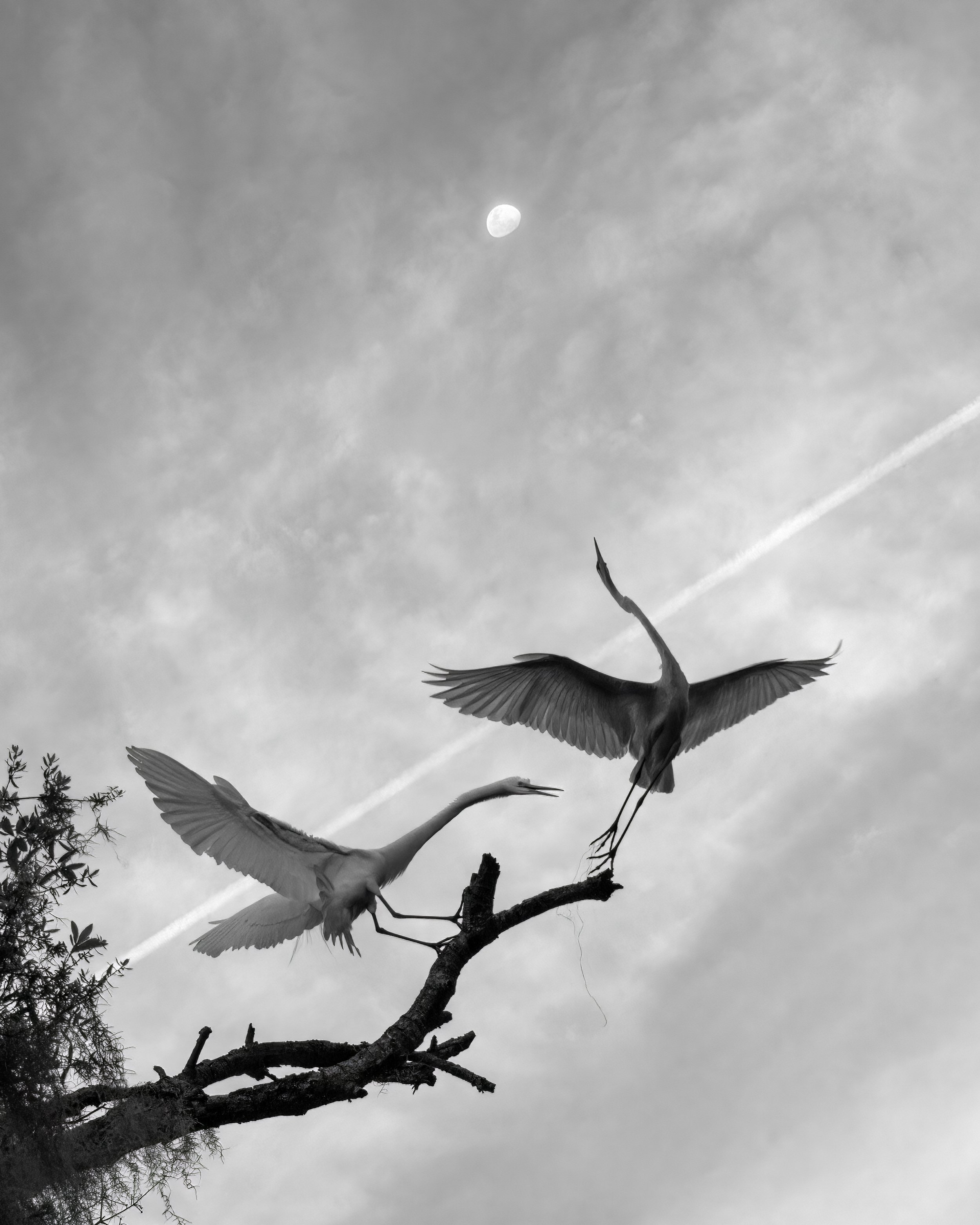Fenqiang Liu
“Morning’s Glory” by Fenqiang Liu
Fenqiang Liu is a fine art nature photographer based in Orlando, known for his ability to capture the enchanting essence of natural Florida and transform it into a paradise within his imagination. Fenqiang's passion for visual art was sparked during his middle school years in China, where he began studying drawing. During college, he discovered his interest in photography and pursued it after completing his BA in Chinese literature.
Fenqiang's photography journey continued when he worked as a cameraman for geographic educational videos, where he refined his skills in videography and photography. Then, seeking further education, Fenqiang ventured to the United States to earn his MFA in Cinema and Photography at Southern Illinois University. After graduation, he worked as a motion graphic designer before starting a business with his wife, providing behavior analysis services for children with autism.
Despite his diverse professional background, Fenqiang has always remained dedicated to his passion for photography. In recent years, he has focused on nature and wildlife photography, capturing breathtaking moments that inspire and captivate his audience. Drawing from his unique blend of cultural influences from both the East and West, as well as his artistic background and photography mastery, Fenqiang expresses his thoughts and emotions through his work in a truly distinct and meaningful way. He has won multiple awards from international photo contests. His photography reflects his passion, creativity, and dedication to the art form.
Hi Fenqiang! Tell us a little about yourself — when did you first become interested in photography and how did you get to where you are today?
I began learning drawing and painting from my uncle and cousin during middle school weekends in China. This continued throughout high school. As there was no photography major in Chinese colleges, I learned to use an analog camera and darkroom techniques from my mother, a forestry professor. She used photography to document plant growth processes for research and teaching. My artistic training was helpful in my photography. After college, even though my major was Chinese literature, I attended a two-week videography workshop. I then worked as a cameraman and photographer for geographic educational video programs and photography projects. Seeking further education, I came to the United States to study cinematography and animation. After completing my MFA degree, I gained experience in computer animation and motion graphics using different software.
After starting a therapy center and a school in Central Florida providing behavior analysis services and education for children with autism with my wife, I didn't have much time for photography. However, I have always had a passion for it. In recent years, I have been able to focus on nature and wildlife photography.
My diverse backgrounds and experiences helped me develop my photography style. My training in drawing and painting gave me better composition and lighting skills and helped me find beauty in nature. My college class about Chinese Tang Dynasty poems contributed to my poetic photography style. Finally, my Photoshop experience allows me to enhance my original photos.
Photographer Fenqiang Liu
“Being a good photographer takes time, patience, and hard work. But if you try your best and are persistent, no matter the result, you will be rewarded on the path during the learning and creating process.”
What are your favorite subjects to capture?
I am very interested in wildlife and landscapes and have a great love for nature. Whenever I'm surrounded by nature, I tend to lose track of time. I enjoy discovering and capturing the magical moments that nature has to offer, moments that others might pass by without noticing.
Living in Florida has its perks; it is a winter paradise for thousands of migrating birds. I have made numerous trips to their nesting locations to capture the most extraordinary moments, and I would like to share their stunning beauty with others.
As your career has progressed, how has your aesthetic or subject matter shifted over time?
When I started wildlife photography a few years ago, most of the photos I saw were zoomed in on the subject, trying to get a sharp picture. There's nothing wrong with that if you want to document what you see or practice basic photography skills, and I've done that too. But soon after, I realized I didn't want to stay at that stage. I love nature and have a passion for fine art. I want to use my photography skills to transform our natural world into art pieces that viewers can enjoy, express my feelings towards nature and art, show viewers how beautiful our planet is, and raise awareness about its conservation.
The essence of ancient Chinese poetry and paintings, where "there is painting in the poem, and poem in the painting," significantly influenced my artistic style. This blend of art and literature deeply inspired me. So, expressing my feelings and emotions through wildlife and natural scenery with poetic visual language has become my passion and style. I love to write poems with camera lenses, so it comes out naturally when taking photos and post-processing.
To achieve the desired artistic effect of the poem in the painting, I use natural lighting, specific objects in the surroundings, and negative space in the frames. When I arrive at the location, I carefully observe the surroundings and decide where I should move to get the best camera angles that will allow me to capture unique compositions. Then, I patiently wait for the most magical moments of the birds taking off or flying by.
The lighting in your images is ethereal and absolutely stunning in what appear to be challenging conditions: existing low light and birds as moving subjects. What’s your approach?
This is an excellent question, and I appreciate your compliment.
I always try to utilize the location's natural light and capture its natural beauty when possible. Some of my best examples are "Moonlight" and "Wings of the Universe," for which I only needed to make minimal post-editing.
Let me explain how I captured "Wings of the Universe." During the spring breeding season in Florida, Great Egrets build their nests high up in trees to protect their young from potential predators. It gave me a unique opportunity to capture photographs of these magnificent birds against the backdrop of the moon. After observing for some time, I noticed that a few days before the full moon in Florida, the moon always rose before dusk. This allowed me to capture the Great Egrets and the moon in the same frame with just enough natural light. I started taking photos of a Great Egret standing on a branch with the moon in the background, and suddenly, another Great Egret flew over and tried to take over the territory. Fortunately, I reacted quickly and captured this dramatic moment as I was in the right place at the right time.
“Wings of the Universe” by Fenqiang Liu
“Moonlight” was captured at night with all-natural moonlight, which presented different challenges. One late afternoon, after photographing the birds until sunset, I stayed late for the full moon. The sky was clear, and the full moon rose, casting a brilliant, ethereal glow. The birds remained on the branches after dark. Since they still moved around a little occasionally, I used a shutter speed of 1/50 sec. to photograph this bird in this low-light condition. I quickly seized this enchanting and dreamlike moment of natural wonder when I saw the bright moonlight outlining the bird, tree leaves, and Spanish moss beautifully. I reduced the noise during post-editing since the natural moonlight was the only light source, and the setting was ISO-8000.
“Moonlight,” by Fenqiang Liu
Sometimes, there are limited opportunities when only utilizing natural light. It is neither practical nor ethical to bring lighting equipment or flash to a natural setting and point it at wildlife. When reviewing some of my original photos, such as "Secret Garden,” "Wings of Confidence," “Color of the Wings,” and “Wings of Courage,” I noticed that the beautiful and elegant motions of birds in flight were captured with perfect timing. After cropping, the compositions added even more uniqueness. The original captures of “Morning’s Glory,” “Wings of Light,” and “Wings of Peace,” were illuminated by natural sunlight from behind, revealing intricate feather details and creating a stunning effect. However, the blue sky in the background was a little flat. Without enhancement, they would only be considered good wildlife photos with significant motion but insufficient visual impact or artist input. Therefore, I approached them from an art perspective and added lights to the backgrounds. This creative enhancement resulted in a dreamy and ethereal image, taking the viewers to a world that exists only in imagination.
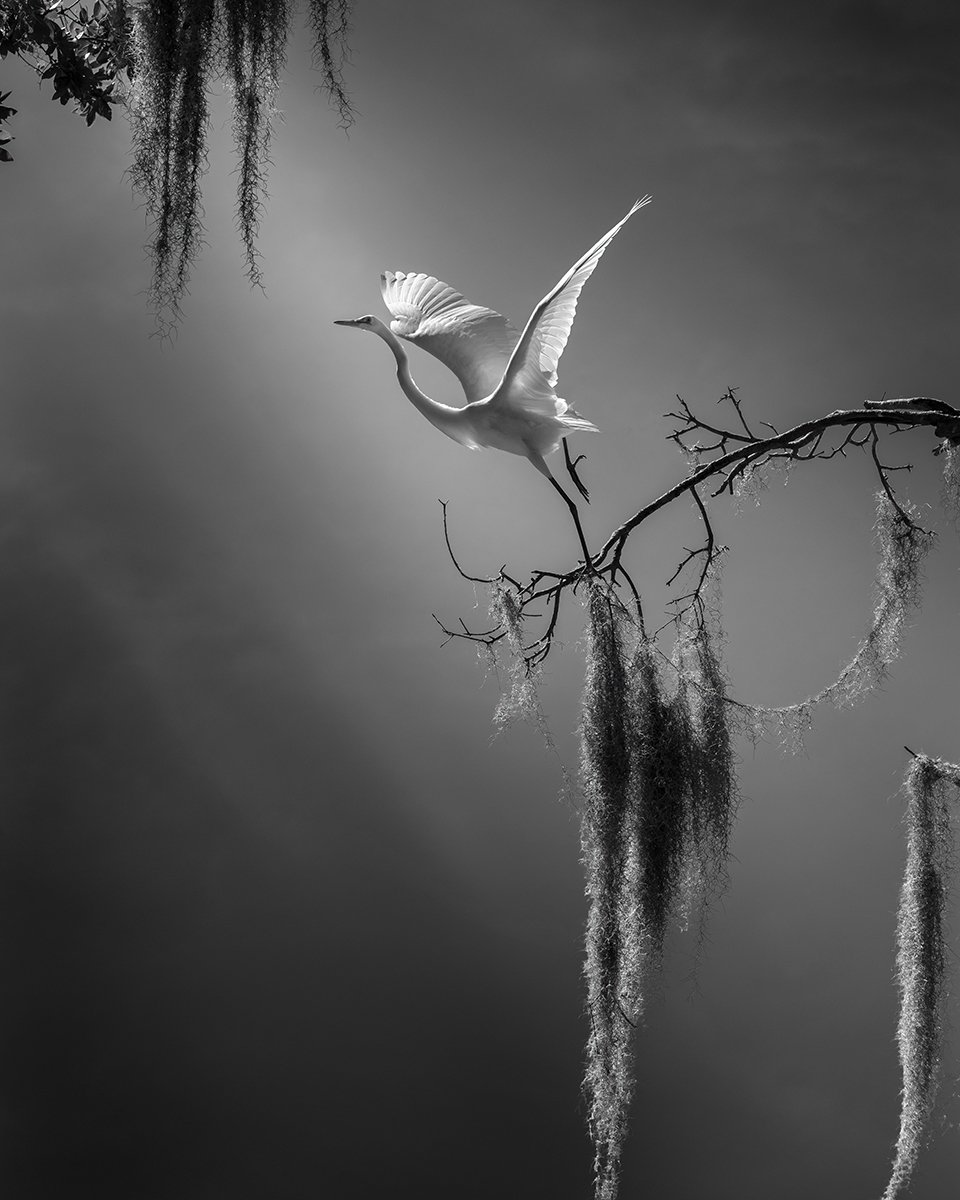
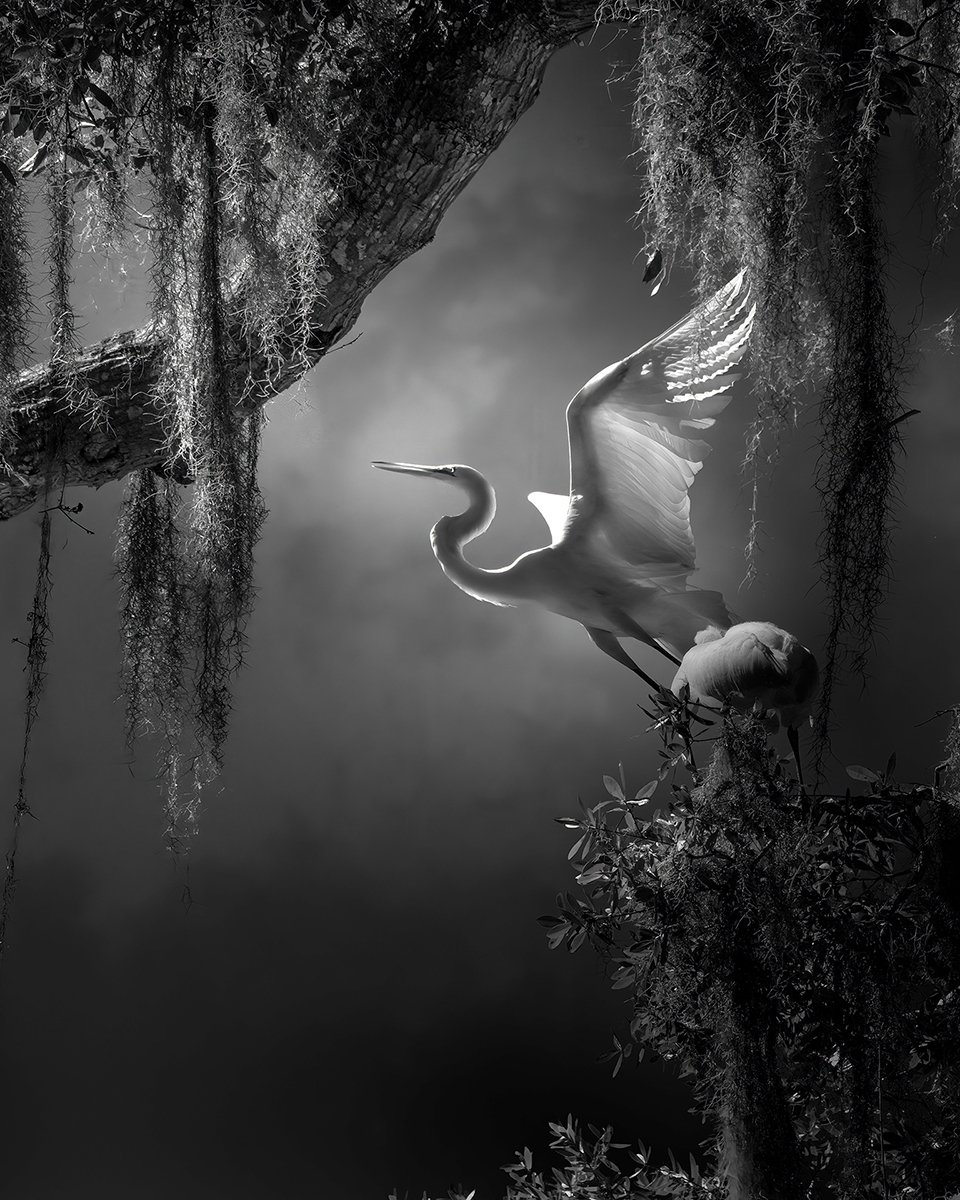
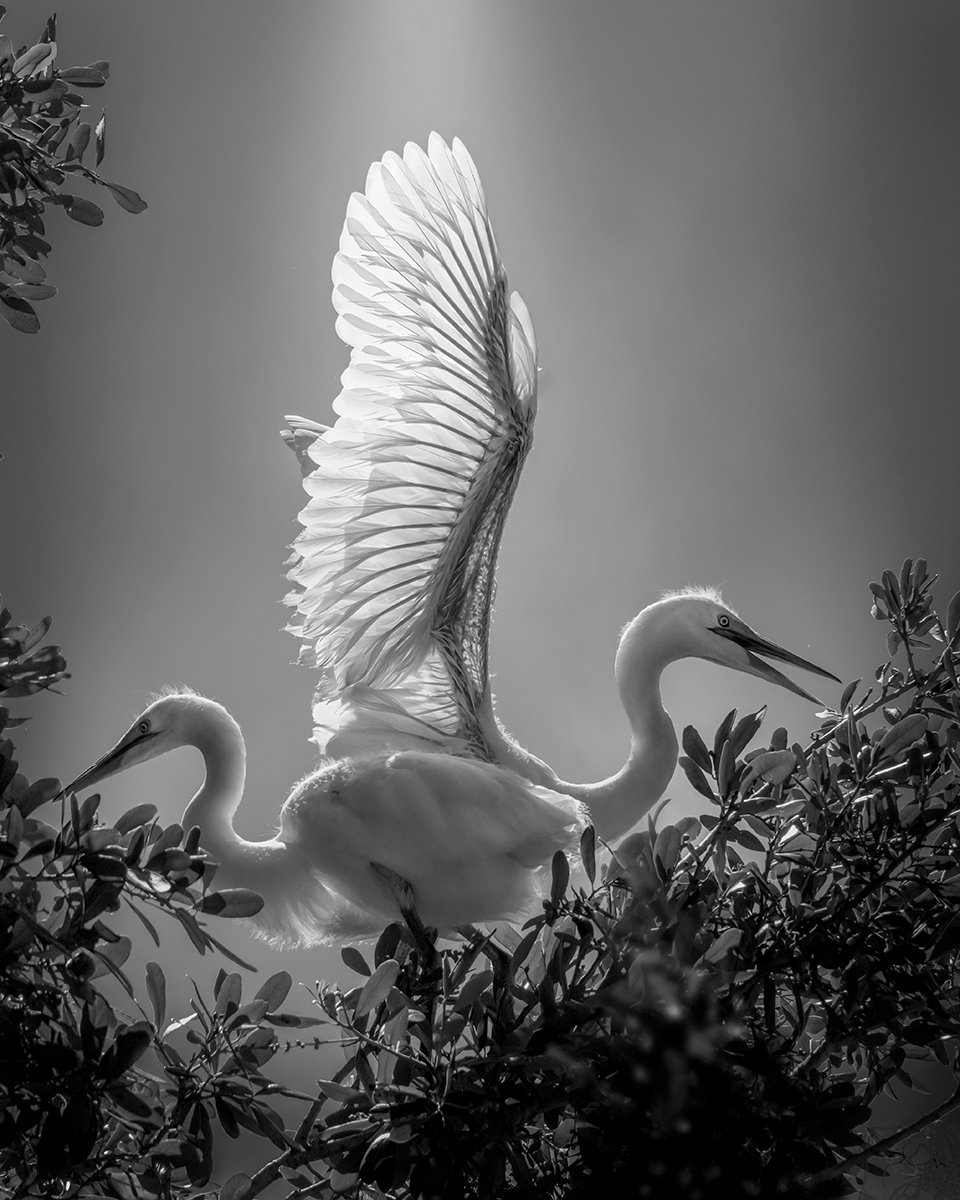
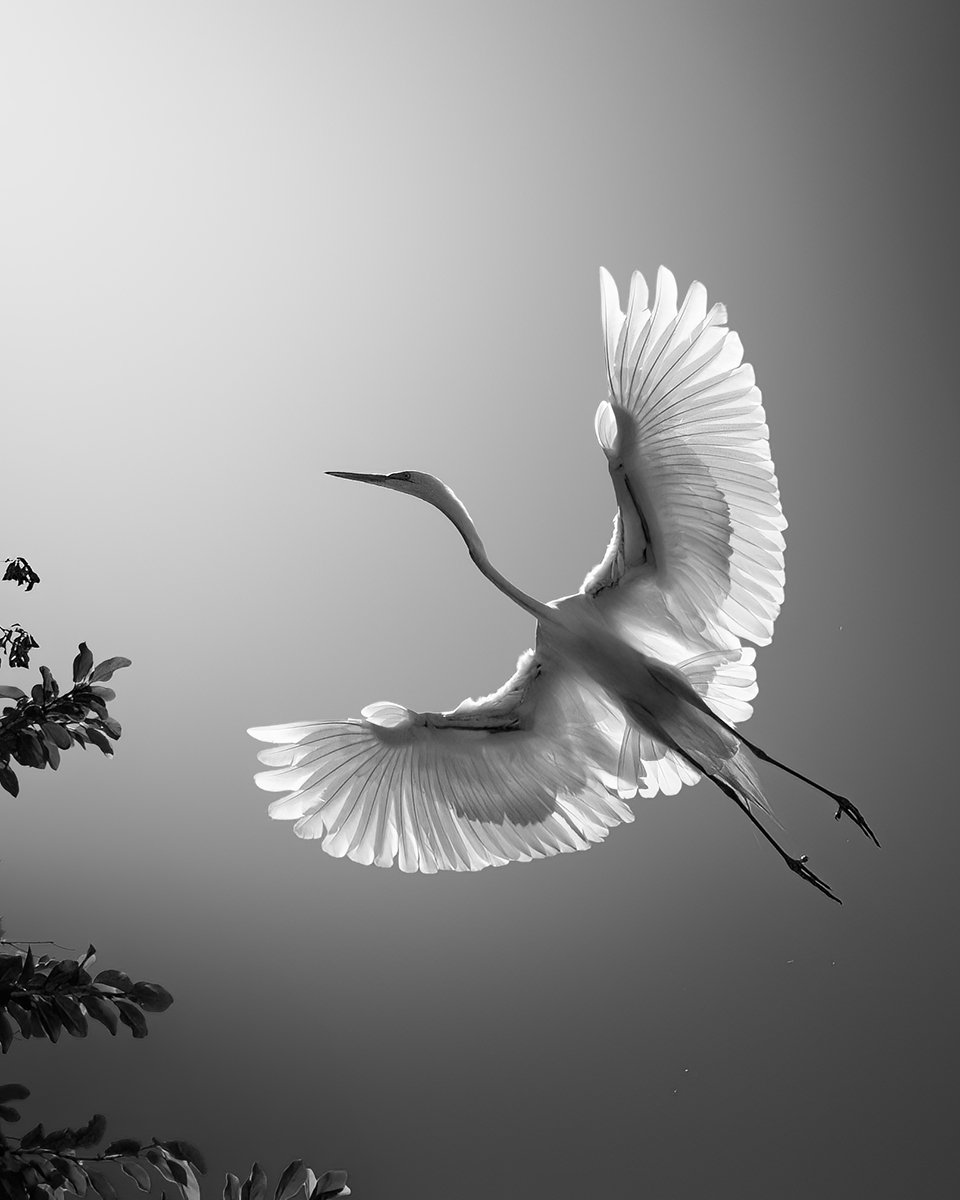
For example, when I took the photo of “Secret Garden,” I utilized the oak branches and hanging Spanish Moss at the location to create a natural frame for the Great Egret. I let its elegance and beauty blend harmoniously with nature while I captured the moment of it taking off from the tree in perfect timing. I carefully selected and darkened the sky during post-processing and added light in the background. It created a mysterious and artistic impression and highlighted the bird’s form, making a striking contrast against the background and guiding viewers’ eyes to the birds.
“Secret Garden” by Fenqiang Liu
Photojournalists who document events or wildlife and landscape photographers for National Geographic or natural history museums must be completely truthful in their reports. As a result, they should avoid modifying their captured photos, except for basic adjustments such as exposure. On the other hand, fine art photographers have the freedom to transform their original captures into pieces of art. They can add artistic value to their photographs and elevate their results to a higher level, just like artists who use paint brushes to express their feelings and show their imagination in their work.
Are there other photographers or resources that you turn to for inspiration?
I always strive to broaden my knowledge by learning from various resources, absorbing the best practices, and developing a unique style that stands out from the mainstream. The poetic concepts portrayed in Chinese Tang Dynasty poems and ancient Eastern paintings are a great source of inspiration for me, particularly regarding the style rather than the subject and content. In addition, European oil paintings have influenced my use of light and shadow in my work.
What gear do you take on a shoot?
I used my Nikon D850 camera to take all the photographs here. A year ago, I bought my first mirrorless camera, the Nikon Z9, and took some pictures, but I haven't had the chance to organize them yet. I stick with Nikon since I've used this brand since learning photography.
The lens that I used for capturing these photographs was the Nikkor AF-S Zoom 28-300 mm f/3.5-5.6. Even though this lens may not be the sharpest, its image quality is still quite good. More importantly, it is a very flexible lens that allows me to quickly zoom in and out, enabling me to capture a wide range of images in front of me without missing a single crucial moment. Whenever I needed to capture the male Great Egrets' courtship displays, such as the "Invitation," or the intimate bonding moments between mother egrets and their babies, such as "Love Language," I would zoom in. On other occasions, I would zoom out to capture images of the birds and their natural habitat, such as the old oak trees with hanging Spanish moss in "Secret Garden" and "Wings of Confidence." This lens is the most practical one for my situation. Currently, I have attached a 500 mm telephoto lens to my second camera to photograph the baby egrets whenever needed.
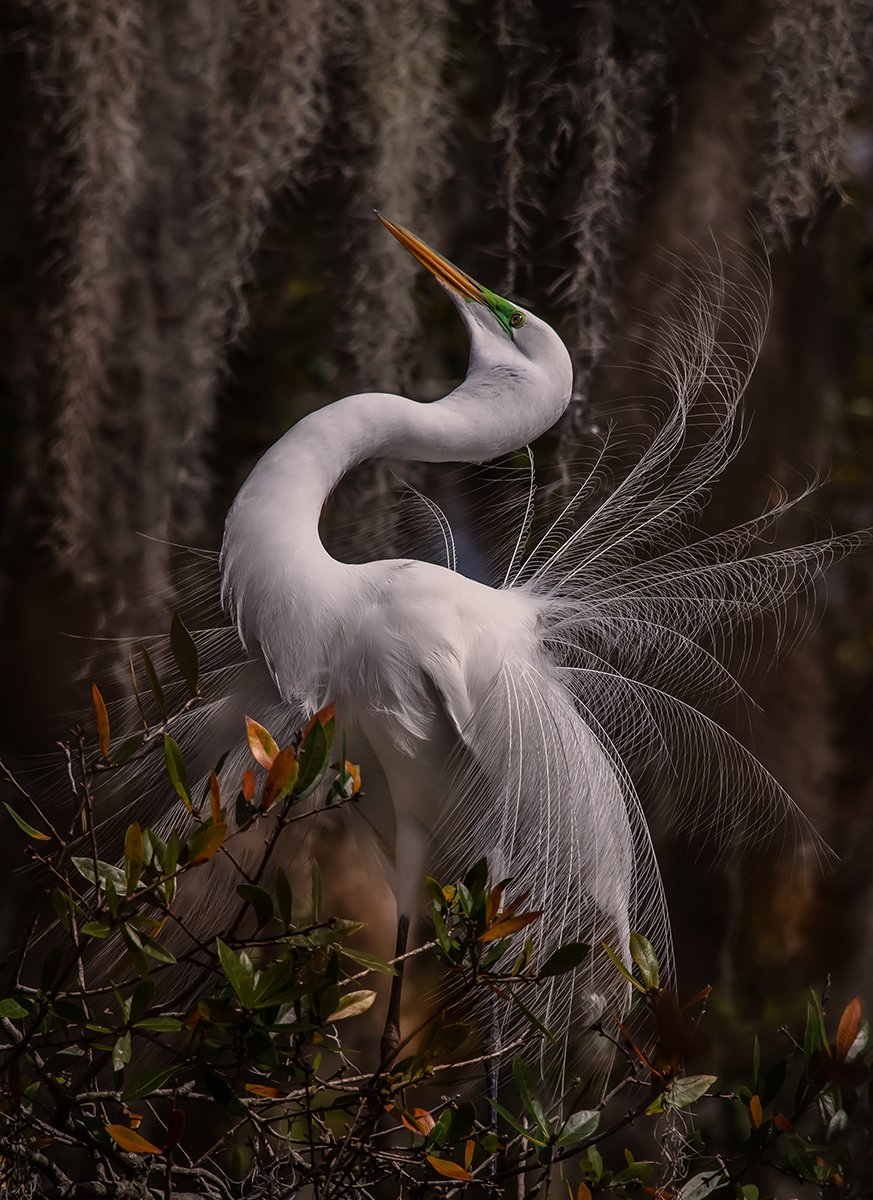
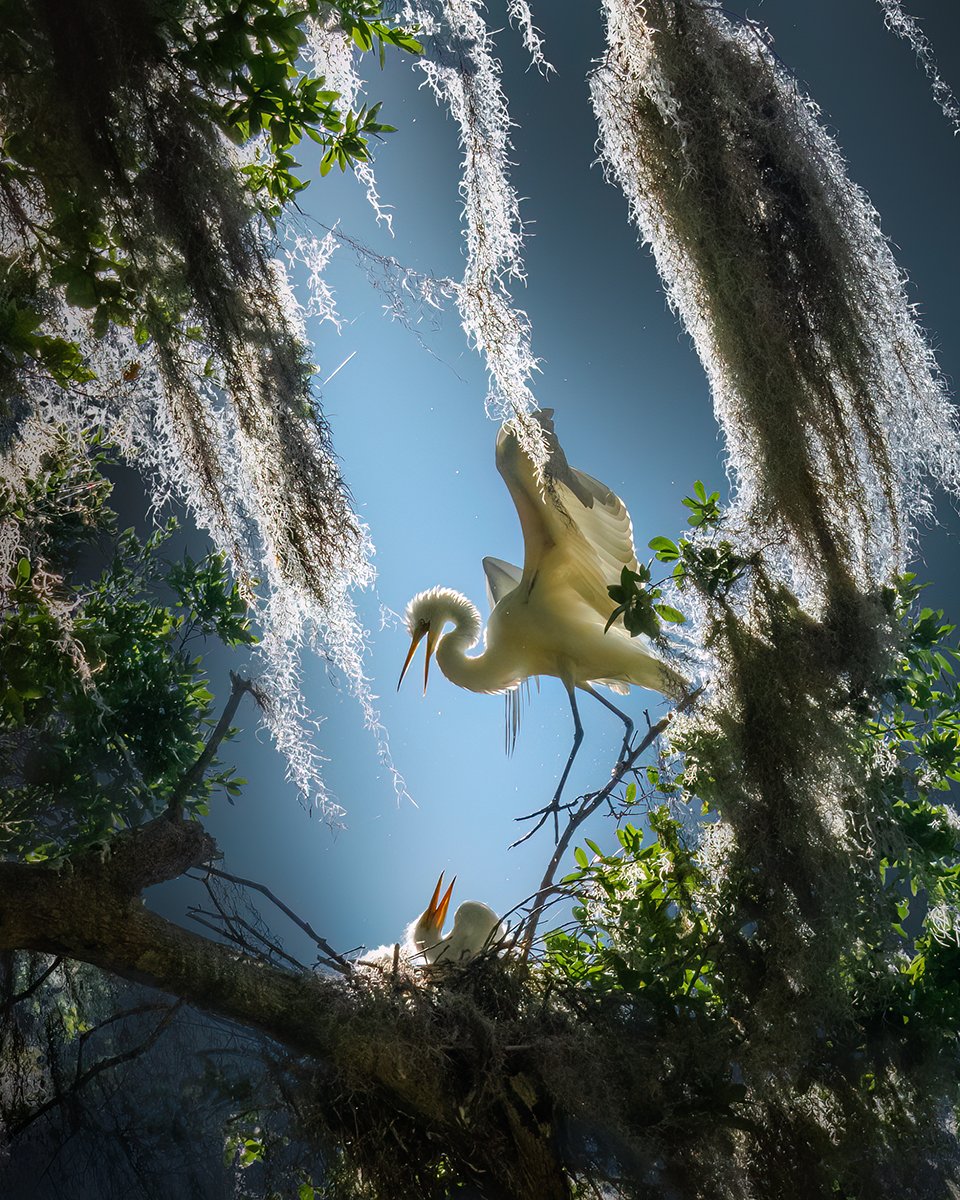
I usually don't use a tripod because it limits my flexibility to change my direction and capture fast-moving objects swiftly. As the birds were within proximity, I preferred using my lightweight zoom lens instead of a heavy telephoto lens. Without using a tripod, I could quickly point my camera upwards when the birds flew over my head, giving me the maximum flexibility to capture the shot.
As both the birds and the moon are constantly changing position, I must frequently adjust my position and angle to ensure that the leaves do not obstruct my view of the birds. For this reason, I find it easier to handhold a camera.
What advice would you give to someone who is interested in photographing wildlife?
If someone is interested in wildlife photography and has the budget for a mirrorless camera with eye-tracking autofocus, it is an excellent option as it can continuously focus on the animal's eyes, even during movement. If the animals being photographed are far away or small, I recommend using a telephoto lens. Otherwise, one can use the Nikkor AF-S Zoom 28-300 mm f/3.5-5.6 lens, which is also suitable for beginners. If one's budget does not allow upgrading to a better camera immediately, one can still use whatever they have to practice photography. The more one practices, the better they will become. It is crucial to know the correct camera settings to use when capturing fast-moving wildlife.
Having a good camera and lens and knowing how to use them well by learning the techniques and practicing is an excellent way to capture sharp images. However, this is not enough to become a fine art wildlife photographer. Having some artistic training can significantly enhance photography skills. Composition is an essential aspect of photography, and one can benefit from studying good paintings to develop composition skills.
Learning from other good photographers’ works is excellent initially, but do not be afraid to experiment to discover your unique style. Being a good photographer takes time, patience, and hard work. But if you try your best and are persistent, no matter the result, you will be rewarded on the path during the learning and creating process.
What's one thing that you want to do with photography that you haven't done yet?
I have always wanted to try portrait photography. I like to challenge myself and test my skills, but I don’t think I have the time for that now. I plan to continue my current work until I have more time for new adventures.
What are you working on now and what’s up next for you?
As I continue working on my ongoing project, "Secret Garden," I have decided to start two new projects called "The Wetlands Are Calling" and "The Charm of the Southern Swamp." Both projects will showcase the natural beauty of the southern United States. Through my art, I aim to inspire viewers by highlighting the beauty of nature and the magic of creativity.
Thank you for sharing with us Fenqiang! To view more of Fenqiang’s work, visit his website and follow him on Instagram.
All images courtesy of Fenqiang Liu



